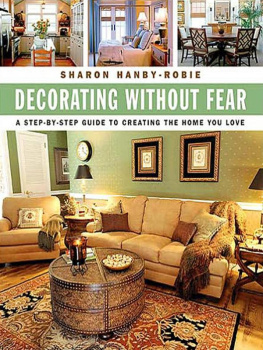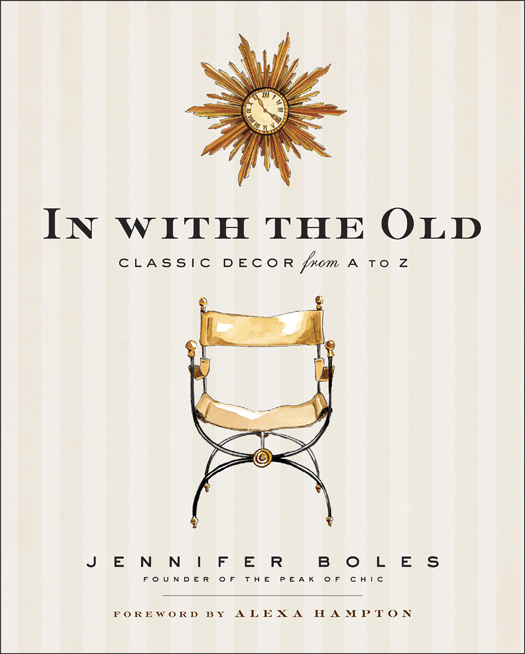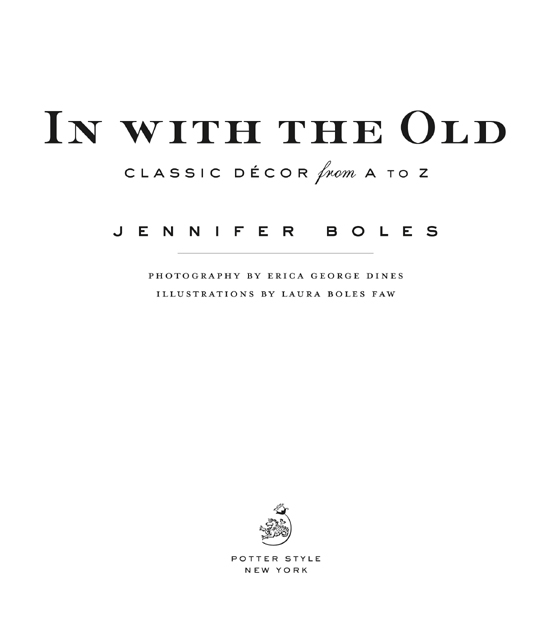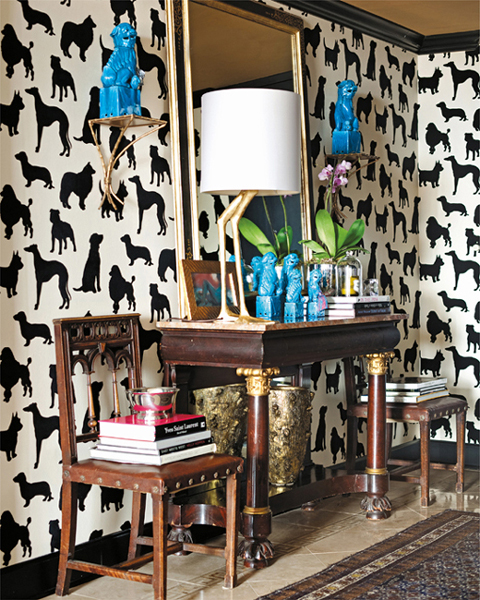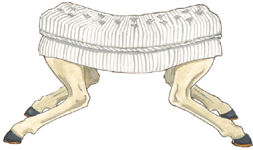Copyright 2013 by Jennifer Boles
Photographs 2013 by Erica George Dines
Illustrations 2013 by Laura Boles Faw
All rights reserved.
Published in the United States by Potter Style, an imprint of the Crown Publishing Group, a division of Random House, Inc., New York.
www.crownpublishing.com
www.clarksonpotter.com
Potter Style is a registered trademark of Random House, Inc.
Library of Congress Cataloging-in-Publication Data
Boles, Jennifer.
In with the old / Jennifer Boles.
pages cm
1. Interior decorationHistory20th centuryThemes, motives.I. Title.
NK1980.B65 2013
747dc232013002756
Hardcover ISBN 978-0-385-34516-3
eBook ISBN: 978-0-385-34517-0
Cover design by Rae Ann Spitzenberger
Cover illustrations by Laura Boles Faw
v3.1
To Billy Baldwin, Eleanor McMillen Brown, Madeleine Castaing, Rose Cumming, Elsie de Wolfe, Angelo Donghia, Dorothy Draper, Frances Elkins, John Fowler, Michael Greer, Albert Hadley, Mark Hampton, David Hicks, Nancy Lancaster, Syrie Maugham, William Pahlmann, Sister Parish, Van Day Truex, Ruby Ross Wood, and all of the other design legends of the past, whose work continues to inspire and dazzle me still today.
CONTENTS
FOREWORD
THERE IS ONLY ONE GUARANTEED WAY TO BECOME A MASTER AT any discipline: to be a master, you must master the material. As a perpetual student of design, I am always amazed by how much good design has been pioneered in the past and I love lingering on the work of the greats and relearning the lessons visible in their practices. I love, equally, perusing the work of present-day designers, especially those whose mastery of their profession and of the subject is obvious. Perhaps the one thing that has worried me over the years is how to sort through the growing glut of images and information out there in this digital age, where everything is to be had and to be seen. How could anyone ever begin to cull and share all of the important images in the hope of showing their examples and exemplars? And how are we to capture and advocate for our historical trove of images, so that it doesnt drown in the swell of current work?
Well I, for one, thank the heavens above for The Peak of Chic s Jennifer Boles. She is now my design historian and my design information curator. With her editorial eye, love of the past, and incredible ability to extract knowledge from images full of cacophonous dataand her transparent joy for her workBoles has become both the author and the guardian of the new interior design canon. In anyones opinion, this is no small feat. And her accomplishments inspire many heartfelt responses. Sometimes my love for her eye is pure: she introduces me to designs I have never seen, that are pristine, and from which she concludes ideas that are profound. Sometimes my love for her eye is profane, when I vainly congratulate myself for having a shared love for an interior designer whose praises she is extolling. No matter which response she evokes, though, I am always engaged by what she has to say.
The most remarkable aspect of Boless ability to assemble and analyze her garden of earthly delights is that as she does it she takes her reader much further into an experience than can be simply explained by displaying images and describing what they show. This book is a rare treasure. On every page Boles invites you to submerge yourself into the era in which these designs thrived, to observe and absorb the customs of the days of their creation. Her writing brings you into the world of her subjects and their milieu, as well draws attention to all of the details. As a result, she creates an almost tangible experience that triggers a sense memoryif youve never lived with chintz or upholstered doors, after reading In with the Old, at the very least youll feel that perhaps you should. Boles teaches us about design, but she also teaches us history, fashion, manners, and style. And, by example, Boles shows us how to love learning about design. Her passion for the topic and her vast store of exhaustive knowledge have made her an ultimate master of her domain.
ALEXA HAMPTON,
author of Alexa Hampton: The Language of
Interior Design and Decorating in Detail
INTRODUCTION
CLASSIC DESIGN NEVER GOES OUT OF STYLE, WHETHER IN FASHION (think of Audrey Hepburns little black dress in Breakfast at Tiffanys ) or interior decorating. If you cull through centuries worth of furniture, fabrics, and decorative details, youll find a wealth of designs that have transcended the ages thanks to their utterly simple lines and shapes, for example, or their perennial good looks and flair. After all, just because the klismos chair can trace its roots to the ancient world, it doesnt mean that its an outdated relic. In fact, the klismos chair remains one of the most modern-looking chairs, something perhaps attributed to its restrained design. And what about toile? Yes, its a traditional fabric, but it can look rather daring when rendered in bright colors and present-day scenes, making it a bold counterpart to contemporary furnishings. And therein lies the secret to decorating with traditional elements: sometimes something old requires a little tweaking, through color, finish, or scale, to transform it into something altogether new.
Decorating and gracious living have always played significant roles in my life, something that I attribute to my Southern upbringing, my house-proud parents, and my familys decorator, a true Southern eccentric of great style and maddening business practices. But it wasnt until an all-night reading marathon of designer Dorothy Drapers now-classic Decorating Is Fun!, that my interest in design history piqued. I marveled that a 1939 how-to decorating guide could inspire me while still providing useful information decades after it had been written. Thanks to Dorothys upbeat book, I set out to learn as much as I could about interiors and designers from yesteryear and began collecting a vast library of out-of-print design books. In 2006 I started my design blog, The Peak of Chic, so that I could share my knowledge with a wider audience and keep the legacies of the design greats alive.
During my years of research, I have been dazzled by Cole Porters glamorous Manhattan apartment, which Billy Baldwin fabulously decorated and appointed with mirrored walls, brass bookcases, and tortoiseshell walls. I fell under the spell of The Dean of American Decorators, Albert Hadley, whose work from the 1960s and 70s still looks moderna feat considering how quickly trends come and go. After years of studying photos of these old interiors, I came to realize that many vintage rooms are chock-full of great design ideas, there for the taking if only one approaches them with an open mind and a discerning eye.
This book compiles the most classic, charming decorative elements from the past and presents them for today. Here youll learn about slipper chairs, banquettes, and bar carts, all of which make ones home party-ready. And ideas for injecting glamour into ones home are woven throughout this book, from satin and rock crystal to mirrored rooms and malachite. If an entry in this book sparks your imagination, by all means have a go at it and incorporate it into your home. Dont be reluctant to experiment simply because your friends and neighbors dont collect porcelain or have trompe loeil wallpaper in their homes. In fact, thats even more of a reason to do so, because these decorative notions will season your home with a personality that is all your own. As Billy Baldwin so aptly put it, The ultimate result should be a room where you are surrounded by the things that really make you comfortable and happy, things that you really love.



